Category Results:
Camp Creative Listed As The
Top Graphic Design Agency By Clutch
How do you convey what you are thinking without using a single word? Charades work but are too interpretive. Dance is an option but not everyone has rhythm. Smoke signals are fun but not ideal for indoor use. This leaves clear and compelling visual design to pick up the slack left by its cousins. With nonverbal communication, whether it be logo design, graphic design, iconography, animation or textual layout, most marketers agree: presentation is everything.
Commitment to User Experience Design
From full website design to graphic element design, everything we do starts with an understanding of the end-user. We take the time to understand what message needs to be sent and how to send it. Everything we design speaks with a clear voice and a carefully curated aesthetic specific to each client and each message. We find that approaching design with both strategy and creativity in mind delivers the best results for our clients and enables us to express complex ideas and emotions in simple, immediately understandable ways.
A Top Digital Service Provider
We have been ranked as the top graphic designer in San Francisco by Clutch, a B2B services consultancy based in Washington, DC. Clutch uses in-depth market research and client reviews to identify top service providers and help firms hire smarter. After evaluating almost 100 of the top graphic designers in San Francisco, Clutch named Camp Creative the number one agency.
Aside from our design capabilities, we have been recognized for our strategic digital marketing expertise with unrivaled SEO skills. This acknowledgement comes to us from The Manifest, a business resource that helps teams leverage their business challenges into opportunities for growth. They highlighted us for our ability to build attractive brands and help them be found a little more easily.
A Fan Favorite
In addition to the praise we have received from industry analysts, we have also received a number of verified reviews from our amazing clients.
When asked what they found impressive about Camp Creative, one client said:
“The way they balance creativity and data management is pretty impressive. It’s rare to find a company with that balance.”
And when asked about the impact of our work on their business, another client said,
“We have seen an increase in our keyword rankings, and the new site looks much better aesthetically than it did before. It conveys that we are a company capable of doing large-scale business.”
Check here to read the full reviews and keep up with what else our clients are saying about us. Thank you to everyone who has worked with us, and helped make 2018 such a great year for Camp Creative. We are proud of everything we have achieved together and are committed to continuous improvement in the future.
Micro-optimization: How to Optimize Your Campaigns Faster and More Effectively
So what is micro-optimizing?
Get ready for some good old fashioned digital marketing nerdsplaining!
Micro-optimizing is using small but statistically significant tests based on micro-conversions to determine what is working best in your campaigns.
It empowers you with the data that you need to optimize your campaigns for better results much faster and more effectively.
What is a micro-conversion?
A micro-conversion is built on Avinash Kaushik’s idea of “micro” and “macro” conversions.
Simply put, a ‘macro’ conversion is going to be whatever is bringing in revenue for your business. Be that software subscriptions, dog training treat sales, or a new client for your agency.
A ‘micro’ conversion is going to be anything that leads up to that macro conversion. I.e someone spending 5 minutes on your site reading your marketing materials. Or someone putting a product in your shopping cart before buying to see what the total cost with tax and shipping would be (tip you should be retargeting these people with abandoned cart ads).
Why do we need it?
Many times, a businesses web analytics measurement model looks something like this:

Image borrowed from Avinash’s blog post – full credit to Avinash.
Most websites are going to a macro-conversion rate around 2%. If you only look at your main conversion that means you are essentially ignoring the 98% of website visitors that did not purchase from you on their visit.
Your measurement should look more like this:
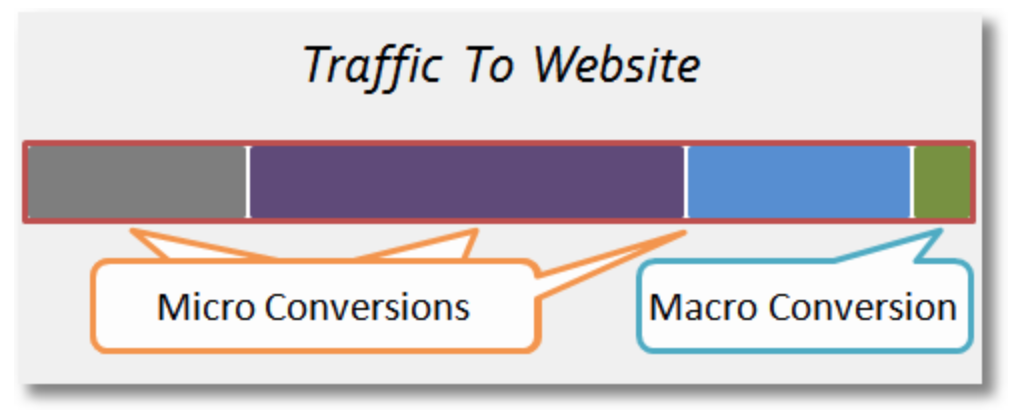
It’s plain to see that filling the measurement model with insightful data is going to give you much more information to use in optimizing your campaign and your businesses performance.
In addition to helping you better understand your website audience, micro-optimizing can be used to optimize your paid marketing campaigns to determine the best:
- Audience
- Ad copy
- Keyword
- Bid strategy
- Landing page
And more….
How can I start ‘micro-optimizing’ my campaigns?
The first step is going to be setting up your measurement model to include micro-conversions. You need to do this in your analytics platform (which is going to be Google Analytics for the vast majority of businesses). Facebook is going to be a little different and we’ll get into that below.
There are many different types of micro-conversions but ultimately the ones you choose should do these 2 things:
- 1. Align with real business goals and objectives
- 2. Correlate to these business goals and objectives. I.e you should know if someone spends 10 minutes on your site that they are more likely to buy than someone who spends 2 seconds. Or someone who requests a free audit is likely to become a client.
- 1. Create the goal in Google Analytics. Kissmetrics gives a good walkthrough here.
- 2. Import the goal(s) into your Google AdWords account.
- 3. Start optimizing!
For a small digital marketing and design shop like ours, we would want to data like:
“Users that spend at least 2 minutes on our site” or “Users that viewed at least 2 pages on our site”. These certainly align with our business goals and correlate with potential client behavior.
For a SaaS company that sells to Marketing VP’s at Fortune 500 companies, maybe their micro-conversion is a PDF download, or a request for product demonstration by a salesperson with a cleverly disguised non-salesy sounding title.
AdWords example:
The best way to do this for AdWords campaigns is to set up some sort of goal in Google Analytics and then import it into AdWords. This will give you the data you want down to the campaign, ad group, keyword, ad level.
This is as granular as you can get, but you’ll need to make sure that your AdWords and GA accounts are linked first.
Facebook Ads:
Facebook does not play well with Google Analytics at all. There is not a direct integration like there is from AdWords to Google Analytics.
Even when you set up Google Analytics tracking URLS (UTM codes) you will probably only see a fraction of clicks from Facebook actually translate into trackable sessions in Google Analytics.
To “micro-optimize” in Facebook, you will want to set up the relatively new Facebook pixel on all pages of your website or mobile app and then setup event tracking and/or custom conversion tracking.
Your custom conversion or event would align with one of these micro-conversions. I.e if someone downloads one of your PDF’s – track that as an “lead”.
How to start micro-optimizing
Now that you have your micro-conversions setup, and you have campaigns up and running let’s look at an example of how you would micro-optimize.
AdWords Ad Optimization:
In AdWords you can “segment” your conversions to see all of the different conversion types that you are tracking and the results tied to your campaign. Note that these are not reported on retroactively so you will only be able to see this data after you complete the steps above.
Here is an example of optimizing ad performance in AdWords using a micro-conversion setup to track users that spend at least 2 minutes on a website.
Ad Testing: Ad “A” Vs Ad “B”
Which ad performs better?
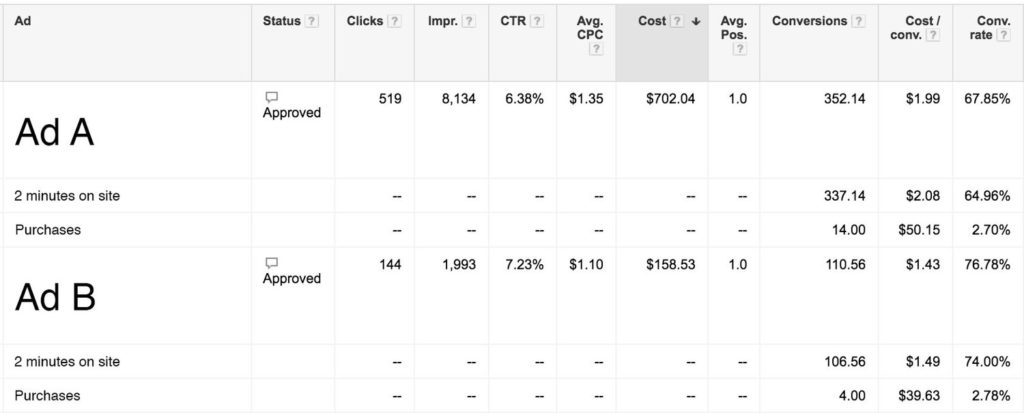
Not using micro-conversion:
Looking at actual “purchases” of the product.
Not enough data again. Either continue to spend budget until there is a winner, or look at micro-conversion data.
Micro-conversion data – statistically significant results:
Looking at views of the shopping cart page instead of actual purchases.
Audience B converts 61% better than A. Optimization action – move budget from A to B or shutdown A entirely. Start a new test, rinse and repeat.
As you can see, doing this will get to to statistical relevance faster, without having to spend as much budget. Ultimately this is going to drive much better performance from your digital campaigns and you will need to spend less to get better results. I don’t know what marketer or business owner wouldn’t want that!
Thanks for reading!
Contact us if you need help or have questions.
5 SEO Best Practices That Matter Most
SEO, search engine optimization, is a phrase that a lot of people tend to throw around while being unsure what it means. But what does optimizing pages for search engines actually entail so that your web page will be among the first results from a Google search?
There are intricate SEO strategies that rely on data science and banks of keywords, but it’s actually not as difficult as it sounds from the outset. Here are the top five best practices you need to stick to if you’re just starting to double down on your SEO efforts.
Best Practice #1: Create Quality Content
What is quality content? Obviously, content that has high production values if you’re talking videos, or is well-written if blog posts and webpages are in question. But a huge mistake that many site owners make is getting hung up on content attributes opposed to the real definition of “quality”: a beautiful combination of what works well with search engines and what your audience wants.
You can have the best writer in the world who has extensive experience with your product, industry, or service. But if their content is missing the mark as to what your audience really wants (such as the 600-word “sweet spot” but they really want long-form content, for instance) and is also just lacking the search terms people are actually using, it’s just not going to fly. Planting is also no longer in vogue: gone are the days you could just paste the same keyword into a blog post 20 times and have it rise in ranking. Your ranking is now affected by how often that page is shared and visited because it’s so helpful, relevant, or entertaining.
You need to invest in understanding your audience and gathering the right data to know what kind of content to create and the ideal attributes it should have. Making this investment is integral to having a winning SEO strategy.
Best Practice #2: Stay Search Engine Crawlable
Crawling is how Googlebot finds new (and updated) pages to add to the Google index. Other search engines use similar bots, also called spiders, to do the same exact thing. These are spiders you definitely don’t want to trap with a cup and put outside! You want them to find your pages and index them.
The spider starts by visiting your main website then following every single hyperlink on that page, and each subsequent webpage. When the spider visits one of your webpages, it will load that page’s content into a database so that it gets added to the search engine’s index. Search engine indices are these mammoth collections of words and where they appear on different webpages. You want your web pages to be in those indices simply because of what people search for.
But if you don’t take proper care of your website, it’s going to be a lot harder for those bots to pick up your site content. There’s the holistic approach to SEO which entails creating quality content peppered with the right keywords, then there’s also the more mechanical parts of SEO which is having a well-designed site map full of functional hyperlinks. You don’t want broken links or links to dead pages anywhere. You also don’t want orphaned pages, which are pages that haven’t been pointed to from anywhere on your main site and are not listed in the sitemap (and subsequently, not in search engine indexes.) This results in lower rankings and less traffic.
Best Practice #3: Employ Responsive Design
Because so much more searching and web surfing is done from mobile devices today, both websites and search engines are beginning to adopt a mobile-first culture. You don’t necessarily have to architect your site to be fully tailored to mobile — but there is at least one aspect of a mobile-first strategy that you should not omit: responsive design. Responsive design is an approach to web design aimed at allowing desktop webpages to be viewed in response to the size of the screen or web browser one is viewing with.
Responsive design isn’t just a great visual strategy, it’s also a very good move for SEO. Google search is transitioning to a mobile-first index, and it in turn has developed a preference for responsive sites. As a result, mobile friendly websites have enjoyed a boost in rankings since May 2016, and that emphasis will continue.
It is also important to ensure that lead generation forms can be easily seen and completed on smaller screen sizes. Responsive design can take care of that.
Best Practice #4: Claim and Optimize Your Google Listings
Google Listings are free listings for Google My Business that give your site more visibility plus local elements like being added to Google Maps and “near me” searches (which are definitely on the rise).
These listings are important for SEO purposes because not only do bots crawl them, but so do people looking up information for your business to see if you’re legit. If you have an unclaimed or inaccurate Google Listing, this can be costly. Not only can it be falsely claimed, but you can lose out on valuable traffic and customers searching expressly for your company’s name. You definitely want to ensure that the contact information in those listings is up to date and accurate.
Best Practice #5: Create Unique Meta Titles and Meta Descriptions
Meta tags, titles, and descriptions are an often-overlooked part of SEO that shouldn’t be ignored. Anything described as “meta” means that it’s the first piece of text someone sees on a search engine results page. Not only is it searchable, but also often the first impression people have. Don’t forget them!
By creating quality content that makes an effort to understand your audience, and keeping your site and listings up to date, you’ll be mastering SEO in no time.
SEO Ranking Factors for 2017
Download the SEO Periodic Table for a more comprehensive experience of search engine ranking criteria, provided courtesy of Search Engine Land.
Let’s Hear From You
What are your SEO challenges? Let’s talk.
SEO Tips and SEO Mistakes to Avoid in a Website Relaunch
Relaunching a website is a fun and exciting process. Whether part of an overall brand refresh, or simply updating an outdated relic, a website relaunch offers a great opportunity to give your brand a more appealing digital presence and boost your lead generation efforts.
A very common mistake organizations make during a website relaunch initiative is excluding search engine optimization (SEO) from the outset. It’s easy to get wrapped up in the visual design and aesthetics of a new site, but designing a beautiful site without incorporating SEO is like buying a new car with an amazing paint job but no engine. Make sure your new site is is as functional as it is beautiful!

…should have looked under the hood.
A surprising number of website design firms are focused on design only, and do not incorporate SEO into their efforts. All too often, those tasked with a website relaunch are new to the process, and are trusting design firms as subject matter experts to deliver the best results. These firms deliver on exactly what they are contracted to do: design and deploy an aesthetically pleasing website, NOT a site that will perform well in search results. Only months later when site traffic has plummeted and bounce rates are through the roof is the question asked, “Is our flashy new site search engine friendly?” The whole experience is like buying a used car off of Craigslist that breaks down right after you buy it.
So how do you avoid a ‘lemon’ with your website relaunch? Here’s a start:
- Incorporate SEO strategy from the very beginning of your website initiative. If engaging with a design firm, ask them directly how they incorporate SEO into their process before a contract is in place.
- Do keyword research and develop a content strategy with your buyer personas in mind. This affects everything: site menus, URL structure, page content, and so on.
- Look at your competitors and how they are ranking for search terms. Evaluate what you want to rank for and how your site content will rank for those terms.
There’s many factors to consider when doing SEO for a site relaunch, so we’ve created a free E-book full of SEO tips to make sure you avoid the common pitfalls: “10 SEO Mistakes to Avoid During Your Next Website Redesign.”

19 Spring Cleaning Tips for Better Marketing Optimization
 Spring is in full swing, and with it the whole idea of spring cleaning is top of mind. We’ve been talking around the Camp Creative lunch table about the bestselling book, “The Life Changing Art of Tidying Up” from Marie Kondo. Her promise of “…living a clutter-free life forever more” is pretty appealing so some of us are trying her methods, to varying degrees of success. For example, I love the idea of getting rid of clothes that no longer fit but still find the blissful state of knick-knack-free nirvana a little elusive.
Spring is in full swing, and with it the whole idea of spring cleaning is top of mind. We’ve been talking around the Camp Creative lunch table about the bestselling book, “The Life Changing Art of Tidying Up” from Marie Kondo. Her promise of “…living a clutter-free life forever more” is pretty appealing so some of us are trying her methods, to varying degrees of success. For example, I love the idea of getting rid of clothes that no longer fit but still find the blissful state of knick-knack-free nirvana a little elusive.
Regardless, this whole idea of decluttering got me to thinking; us marketers probably have plenty of clutter we can purge. Best practices that we should follow get lost in the shuffle of our everyday hustle and bustle. And in the process our tidy marketing efforts are less efficient — and productive — than they could be. So I’ve put together this list of 18 spring cleaning tips for marketers. Now that the craziness of conferences like SXSW has subsided, its time to do some spring cleaning!
Now, we work with a whole range of companies, from 2-person startups to Fortune 100 companies. So, some of these marketing optimization tips may not apply, especially if you’re in a larger organization with a more focused set of responsibilities.
Tips for CRM and Marketing Automation Platforms
Remove duplicate records from your CRM.
Duplicate entries can cause a whole ton of problems with CRM software. Whether it’s a lazy sales team entering data or improperly configured lead capture forms, there are many ways for duplicate records to creep into your CRM. If you’ve never run a dedupe, or if its been awhile since your last one, do yourself a favor and run an audit on your database for duplicate records. You may be surprised at what you find!
 There are a lot of vendors that provide dedupe software for just about every CRM out there. If you can’t find the budget for an ongoing license, see if you can run an initial dedupe with a free trial.
There are a lot of vendors that provide dedupe software for just about every CRM out there. If you can’t find the budget for an ongoing license, see if you can run an initial dedupe with a free trial.
Remove any obvious bad data or bad leads from your CRM.
Similar to running a dedupe, do some searches in your database for leads who have the first or last name value of, “Test,” or “asdf,” or similar garbage values that can be removed. Cleaning out junk records like this will improve the accuracy of your overall reporting.
Audit your lead database for improperly capitalized records.
Sometimes leads will get entered with improper capitalization of the first name or last name field. For example, “John Smith” gets entered in as “john SMITH.” Leaving these records improperly formatted can make you look a little silly in your email marketing if you use personalization tokens with your emails.
For example, using personalization in an outbound email campaign with this lead record might produce a subject line like this:
 “Hey john! Check out our latest white paper…”
“Hey john! Check out our latest white paper…”
“Hello Mr. SMITH, check out Booth 465 at this trade show…”
“Good Afternoon JOHN…”
It’s AWKWARD. I mean, it’s awkward.
Fortunately, there’s a quick and easy fix: export your data to an Excel sheet, and then use the “PROPER” function to correct everything. You can fix your entire database in under 10 minutes. Then, upload your spreadsheet and append your lead records. Voilà! Once you’ve run this update you can rest assured that your personalized emails don’t look like a 6th grader’s text message. (Check out instructions on Excel’s “PROPER” function here.)
Audit your lead scoring system in your marketing automation tool with some real sales info.
If you are using a marketing automation platform, odds are you are using lead scoring for your nurture campaigns. The thing about these systems is, they are never one-size-fits all. Every lead scoring system has to be customized to a particular company’s needs. If your system has been up and running for a while, the reality of your lead scoring requirements might be different from your initial assumptions during setup.
Take a sample of actual deals that closed, and trace them back to the top of the funnel to their first touch point. For each lead, look at how their lead score accrued as they progressed through your sales funnel, and ask yourself if your scoring system still makes sense. Should they have been upgraded to a marketing qualified lead sooner? Later? Should someone on your sales or marketing team received a notification about some activity that this lead did? Odds are, you will have some adjustments to make with the nuts and bolts of your lead scoring system.
Audit your report and dashboard setup.
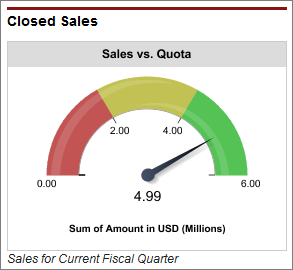
Think about how your team is using your CRM and/or marketing automation platform. Do your reporting templates meet your needs? Does the dashboard/user interface deserve any customization that you may have missed on initial setup? A slight adjustment in the UI might drastically improve your team’s productivity.
Archive outdated landing pages and set up 301 redirects.
If you have landing pages for expired offers, consider archiving them and setting up 301 redirects. For example, if you have a landing page for an offer specific to a trade show from 2014, setup a redirect to the landing page for the 2015 event’s landing page.
Tips for Sales and Marketing Collaboration
Talk to your sales team about what’s working and what isn’t.
Streamlined organizations often have this built into their processes, so this may seem like stating the obvious. But its important so I’ll say it anyways. Go talk to your sales team and ask them what is working! What type of marketing assets do they need more of? What is helping them close deals? What is extraneous? What kind of leads are getting the best response and close rates?
Also, make sure you talk to people at varying levels of the sales organization. Talk to sales execs, inside sales reps, sales development reps, and so on. If there is a sales operations person(s) in your organization, talk to them as well. Your sales ops team might be able to provide you with hard data on what marketing collateral is getting used the most.
 Review your buyer personas and see if they still ring true.
Review your buyer personas and see if they still ring true.
Buyer personas are always evolving. Review your personas with your sales team and see if they still make sense. Do any personas need adjusting? Are any missing? Which personas are driving the most revenue?
Tie off any loose ends with old projects.
Projects get put on hold all the time for a myriad of reasons. Look at your list and see if anything should be revisited or wrapped up. Sometimes reaching out about old projects can lead to new projects for your pipeline.
Tips for Website and Online Presence
 Check your website load time.
Check your website load time.
A slowly loading website can send your bounce rates through the roof. Your site may have been optimized when you first launched it, but any number of factors might have changed since then, affecting your page load times. Check your page load time using a free tool like ping-dom or webpagetest.org.
Check up on your Google Analytics.
If you are involved in your company’s website, you are likely doing this as a regular part of your routine. However, at smaller organizations like startups, oftentimes marketers are so overwhelmed with their to-do list, looking at web analytics gets lost in the fray. Take a look at your your heat maps, bounce rates, traffic trends, and so on.
Review your site in Google Webmaster Tools.
Its always good to know how Google sees your site. Go to your Webmaster tools account and audit/update your XML sitemaps, check for any 404 errors, test your robots.txt file, and given the “Mobilegeddon” update of April 2015, double check the Mobile Usability dashboard. (And if you haven’t heard of Mobilegeddon yet and your site isn’t mobile friendly, I encourage you to read this immediately.)
Check your site in search.
Do searches for your company name in Google and Bing. Find out where you stand in branded search.
Check your competitors’ sites in search.
Where do your competitors stand in their branded search?
Check search engine results for your targeted keywords.
What keyword strings are you ranking well for? What do your competitors rank well for? What are you up against?
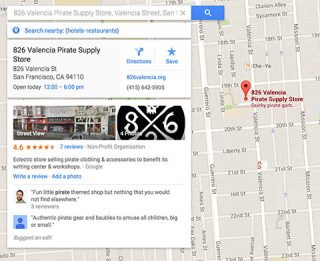
These pirates are on top of their SEO game.
Check your company info in Google Maps and Google+.
It may have been a while since you last checked your Google Maps listing. Not too long ago, Google released “Google My Business” as an easy way to keep your listings up to date. Keeping this information up to date is critical for two reasons. First, your customers know how to find you. The second reason is that you will get a nice SEO boost as a result. (For details on the SEO component of Google+, check out these posts on Social Media Examiner and Moz.)
Check your Yelp listing.
You may be thinking, “I don’t work for the kind of company that is on Yelp.” Even so, someone else may have added your listing without your knowledge. (For example, if someone “checks in” at your office during a job interview.) Take a look at your listing and make sure everything is in order. If you don’t have a listing, create one. This is low hanging fruit for an easy SEO boost.
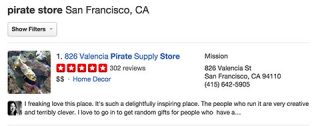
Even swashbucklers use Yelp!
Check in on your social media accounts.
This is going to vary widely from person to person and company to company, but here’s some ideas on what this ‘check-in’ could mean. Is all your profile information current and aligned with the rest of your online presence? If you don’t manage your company’s social account, is the person managing your account doing so effectively? Is he or she clear on the strategy, and what their performance metrics are? Has your social media effort made any contributions to your lead generation? Have there been any negative incidents on social media? If so, are those incidents being handled/managed effectively?
Check your site search functionality.
Check your site’s search feature
If your website has a search feature, put yourself in a customer’s shoes and do a few test searches based on terms they would use. Does the right information pop up in the results?
Do you have any good spring cleaning tips for your marketing programs? Let me know in the comments or message me on twitter @chucktothejones. Happy cleaning!
Get Ready for the Google Algorithm Update April 2015: Mobile SEO
“Mobilegeddon” is coming April 21. Get your site’s mobile SEO ready now.
Every few years, Google releases a major algorithm update that has a dramatic effect on how your site appears in a search engine results page (SERPs). Recently, Google announced a new algorithm update focused on mobile search:
Starting April 21, we will be expanding our use of mobile-friendliness as a ranking signal. This change will affect mobile searches in all languages worldwide and will have a significant impact in our search results. Consequently, users will find it easier to get relevant, high quality search results that are optimized for their devices.
What does this all mean? If your site is not optimized for mobile devices, you will lose out in search results to your competitors that are mobile-friendly. One nuance of the update is that it is on a page-by-page basis. For example, if your home page is mobile-friendly but other pages are not, you will be penalized in SERPs. You can verify your mobile status with Google’s Mobile-Friendly Test Tool, and get more granular data on any issues your site is having with Google Webmaster Tool’s Mobile Usability Report.
The folks over at Search Engine Land, Search Engine Watch, and Moz have all done great write-ups on the pending update, full of great tactical advice on how you can prepare for the change. Marketing TechBlog has also put together a nice guide on mobile SEO in infographic format. If you are concerned about your site’s mobile SEO and how you can be prepared for the Google algorithm update April 2015, feel free to get in touch with us.
What We Search for and Why – On Page SEO Best Practices
If you are a marketer with many hats, you probably don’t have a lot of time to dig too deeply into on page SEO best practices. This blog post by Neil Patel caught my eye. A quick scan will reveal some simple techniques that use branded keywords to get better brand identity by new and repeat visitors.
WHY IT MATTERS
Search algorithms update continually, but what we search for and why, stays reasonably constant. Hubspot contributor, Neil Patel, outlines three key search types that people perform – navigational, informational and transactional, then explains with visual clarity, specific optimization techniques, matched to each search type.
Check out the full post here: 9 SEO Techniques to Dominate the Most Popular Methods of Content Discovery

